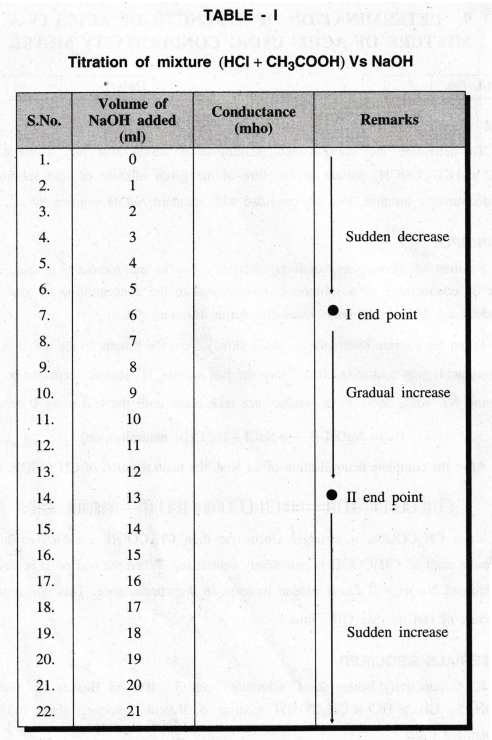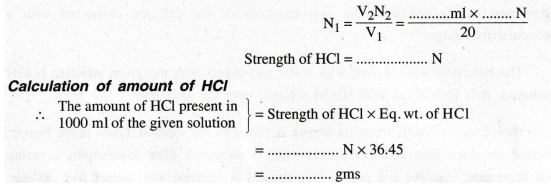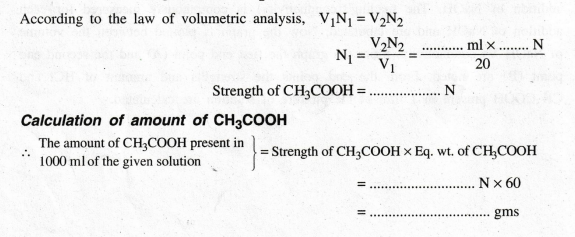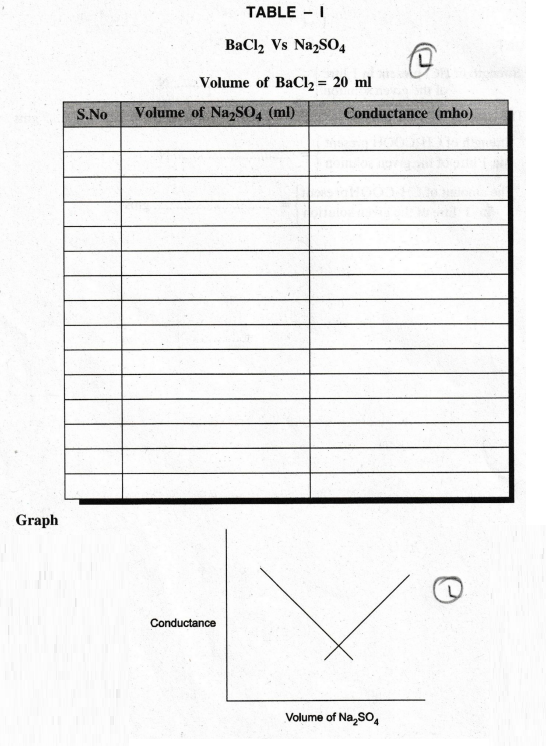Engineering Chemistry Laboratory Practical
9. Determination of strength of acids in a mixture of acids using conductivity meter
Chemistry (Lab) Practical
To determine the strength and amount of a strong acid and a weak acid (HCl and CH3COOH) present in one litre of the given mixture of acid solution by conductometric titration. You are provided with standard NaOH solution of ........N.
9. DETERMINATION OF STRENGTH OF ACIDS IN A MIXTURE OF ACIDS
USING CONDUCTIVITY METER
Expt.
No.
Date:
AIM
To
determine the strength and amount of a strong acid and a weak acid (HCl and CH3COOH)
present in one litre of the given mixture of acid solution by conductometric
titration. You are provided with standard NaOH solution of ........N.
PRINCIPLE
Solution
of electrolytes conducts electricity due to the presence of ions. Since
specific conductance of a solution is proportional to the concentration of ions
in it, conductance of the solution is measured during titration.
When
the sodium hydroxide is added slowly from the burette to the solution, HCl
(strong acid) gets neutralised first. Since the fast moving H+ ions
are replaced by slow moving Na+ ions, decrease in conductance take
place until the end point is reached.
HCl
+ NaOH → NaCl + H2O (Ist neutralisation).
After
the complete neutralisation of all HCl, the neutralisation of CH3COOH
starts,
CH3COOH
+ NaOH → CH3COONa + H2O (IInd neutralisation).
Since
CH3COONa is stronger electrolyte than CH3COOH, conductivity slowly
increases until all CH3COOH is completely neutralised. When the end
point is reached, addition of NaOH will cause sudden increase in the
conductance. This is due to the presence of fast moving OH- ions.
MATERIALS
REQUIRED
1.
Conductivity bridge 2. Conductivity cell 3. 100 ml Beaker 4. Standard NaOH 5.
Given HCI & CH3COOH mixture 6. Burette, pipette, glass rod etc., 7.
Distilled water.

PROCEDURE
TITRATION
The
given mixture of acids (HCl + CH3COOH) is transfered into 100 ml
standard flask and made upto zero mark using distilled water. 20 ml of the made
up solution is pipetted out into a clean 100 ml beaker. The conductivity cell is
placed in it and then diluted to 50 ml by adding conductivity water, so that
the electrodes are well immersed in the solution. The two terminals of the cell
are connected with a conductivity bridge.
The
burette is washed well with water and rinsed with the given standard NaOH
solution. It is then filled with NaOH solution upto the zero level.
Now
1 ml of NaOH from the burette is added to the solution, taken in the beaker,
stirred for some time and then conductivity is measured. (The conductivity is
going on decreasing upto the end point). This process is repeated until atleast
five readings are taken after the end point (A) has been reached.
After
the end point, again NaOH is gradually added, which causes increase in
conductance. This increase in conductance is observed until the end point (B)
is reached.
After
the second end point, sudden increase in conductance is observed on further
addition of NaOH. The reading (conductivity) is continuously measured for each
addition of NaOH and are tabulated. Now the graph is plotted between the volume
of NaOH Vs conductivity. From the graph the first end point (A) and the second
end point (B) are noted. From the end points the strengths and amount of HCl
and CH3COOH present in 1 litre of the mixture of solution are calculated.
Step
I
Calculation
of Strength of HCI
Volume
of the mixture (HCl), V1 = 20 ml
Strength
of the mixture (HCl), N1 = ............. ?
Volume
of the NaOH, V2 = .............. (A) ml (Ist titre value)
Strength
of the NaOH, N2 = ....... N
According
to the law of volumetric analysis, V1N1 = V2N2

Step
II
Calculation
of Strength of CH3COOH
Volume
of the mixture (CH3COOH), V1 = 20 ml
Strength
of the mixture (CH3COOH), N1 = ....... ?
Volume
of the NaOH, V2 = ........... (B - A) ml (IInd titre
value)
Strength
of NaOH, N2 = ........ N.
According
to the law of volumetric analysis, V1N1 = V2N2

RESULT
(i)
Strength of HCl present in 1 litre of the given solutions = ……… N
(ii)
The amount of HCl present in 1 litre of the given solution = …….. gms
(iii)
Strength of CH3COOH present in 1 litre of the given solution = ……..
N
(iv)
The amount of CH3COOH present in 1 litre of the given solution = …….
gms

Engineering Chemistry Laboratory Practical : Tag: : Chemistry (Lab) Practical - 9. Determination of strength of acids in a mixture of acids using conductivity meter
Related Topics
Related Subjects
Physics and Chemistry Laboratory
BS3171 Practical Experiment 2021 Regulation | 1st Semester Common to all Dept 2021 Regulation
